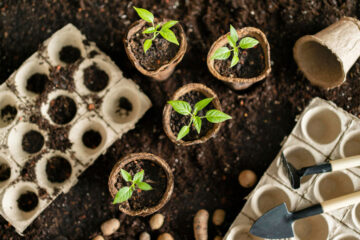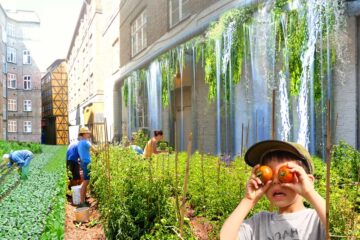When winter is right around the corner we need to give special attention to our vitamin intake. In this period of the year, it is harder to obtain food that is full of appropriate vitamins and minerals. But then what can we do on these gloomy, cold days?
Gardening, of course!
The assumption might seem weird at first, but you do not have to imagine large agricultural work, because it works just in a small, between the four walls as well. Here are 3 advice, that will help you to grow edible plants inside:
1. Germination
The germs contain the full-grown plant’s essence, they are extremely rich in minerals, vitamins, and enzymes, and therefore their health-protective effect is outstanding. The germinating seeds’ enzyme production reaches the highest level that the plant won’t reach anymore during its development.

The foundation of a healthy diet is a green diet and continuous germ culture. It is no coincidence because the germs contain a lot of enzymes that are essential for the growing plant.
The consumption of bio germs – even as a cure – is especially important, because is our health at risk if we do not have enough enzymes in our organism.
Since it is almost impossible to get bio and fresh food in most places, this natural way to healthy nutrition really deserves our attention. Enzymes are complex catalysts, that inspect all the chemical reactions of our organisms. We are born with a certain amount, which should be enough for life.
Improper lifestyle, poor nutrition, and diseases consume vast quantities, so over time the balance is disrupted, and the body is more and more exposed to serious diseases such as depression, hair loss, tooth decay, and high blood pressure.
Germs are excellent sources of Vitamin A, B-complex, C, D, E, G, K, U, and minerals like calcium, magnesium, phosphorus, chlorine, potassium, sodium, and silicon, they are all present in their natural form, which the body uses the easiest way. The new life is burst out from the tiny seed produced with huge energy and it contains all the necessary components, which the body needs for health.
Bio germs contain 25% more calories than meats, but they are not fattening (they give us instant energy since they are „alive food”), they do not contain fats, cholesterin, hormones, or antibiotics, and are 100% digestible. They contain the elements that are essential for a healthy lifestyle in the perfect combination. It’s a real pleasure to grow germs because you do not have to be dirty from head to toe to be successful, what is even more you can do it in a block flat as well.
All you have to do is to devote them 1-2 minutes a day and in 3-4 days you will already see the results.
How to germinate seeds
You will need a germing bowl (plastic versions are easily washable), paddy and chemical-free seeds, oxygen, and water.
It is advisable to use cereals (wheat, barley, rye), pulses (lentils, beans, peas), nuts and seeds (sunflower, flax seeds, pumpkin seeds), or herbs (mustard, watercress, buckwheat) for germing, because they contain vitamins and important enzymes that improve digestion.
Germing is really easy: Just fill the germing bowl with pre-washed seeds, pour warm, clear drink water on it, and let them soak for half of the day. After soaking, rinse them with warm water again and place them in the bowl with holes. You should sprinkle them kind of far from each other because they can grow five times their original size. From then on all you have to do is water them gently each day. It is important to not let the water fill below the seeds because they could easily get moldy.
You can already see the results after 3 days and you will be able to harvest the fruits of your work for weeks. The germs that are not consumed should be kept in bags or glass in the fridge so it stays fresh, what is more, it evolves for a few weeks.
2. Planting
If you are considering urban backyard farming, it is worth spending your winter evenings planting. You will most likely find an empty box of yogurt, which probably is the best place for your future plants.

We can buy special peat or paper containers as well which comes with the advantage of being able to plant the grown seedling with them, and because they are made of natural material, it decomposes in the soil and the plant will not interfere during the transplanting. It is rewarding to plant crops that require a higher temperature for germination (tomatoes, peppers, carrots, lettuce).
Before seeding look after that particular plant and check its required temperature for germination. We generally grow those plants as seedlings that require 20-24 C consistent temperature.
This temperature range provides the appropriate light intensity (with light), sufficient moisture, and nutrients in the soil, therefore it provides lively growth for young plants. So if you want to plant a seed that you have not dealt with before it is essential to look for information about it, you can read about them even in their bags.
If the mentioned environmental conditions are not appropriate for the plant’s needs, the germing slows down, germs could die and seedlings are weak. Only germs grew at appropriate temperature germ fast and develop powerful leaves. If we can not provide sufficient conditions at home, we should not get into germing.
Fill the bottom punched boxes with a peat and sand mixture of half and half, then sprinkle the seeds into them. Afterward, sprinkle them thoroughly with water and they should be kept in a warm, bright place.
The germs require water, so you should always keep the soil wet. After the first seed leaves appear, it is advisable to reduce the amount of water so the younger germs won’t rot. 2-3 weeks before planting you can „train” the seedling so the plants could get used to the environmental conditions outside. That means 18-20 degrees by day but they should be kept at a closed place at night (when it is colder).
3. Growing Microgreens
Microgreens are kind of small, edible green plants, which can also be grown from seeds. The production process consists of germination in the ground and quick harvesting.

Their great advantage against germs is that there is no risk of food poisoning (Salmonella, E. coli). These plants, although they are small, they offer surprisingly vibrant flavors. The microgreens (celery, sage, fennel, mustard, parsley, radishes, sorrel) are excellent side dishes, but you can use them for decorating or highlighting flavors.
It is important to know that microgreens are not germs, because they do not grow in water. Instead, the seeds are grown in peat moss or other fiber-rich soil.
They require low humidity and good air circulation with a clear, sunny space. Seeds should be put further from each other because during their development they will fill a relatively large space.
Depending on the species you can harvest your first delicious microgreen in 2-6 weeks and they can be harvested for up to a further 90 days. If we overproduce our favorite greens, it is advisable to put them in bags and put them in the fridge.
Conclusion
There are several benefits to growing edible plants in the wintertime. One of the main benefits is that you can have fresh produce during the winter months when many other fruits and vegetables are not in season. This can help you eat a more varied and healthy diet.
Growing your own food can increase your self-sufficiency and reduce your reliance on the grocery store. This can be especially important in the winter when weather conditions may make it more difficult to get to the store.
You have control over what goes into it and how it is grown. This can be especially important for people who want to avoid pesticides and other chemicals that may be used on conventionally grown produce.
Gardening has been shown to have numerous mental and physical health benefits, including reducing stress and anxiety, increasing physical activity, and improving cognitive function.
In summary, growing edible plants in the wintertime can provide you with fresh produce, increase your self-sufficiency, give you more control over your food, save you money, and improve your mental and physical health.




